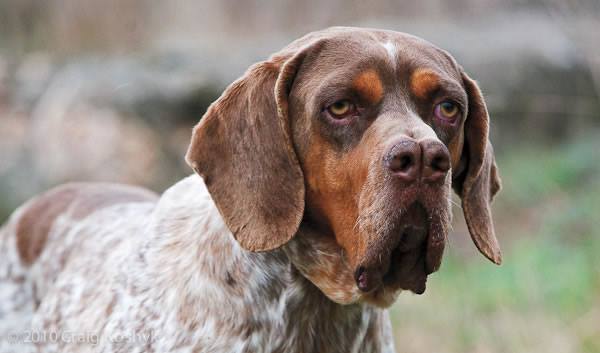
We don’t talk a lot about nostrils at NPDD, and we should because in some breeds, it’s important enough to mention in the breed standard. One such standard reads, “Nostrils well open to permit deep breathing of air and adequate scenting. Tight nostrils should be penalized.” In what breed could nostrils be so important as to DQ a dog for having “tight” ones in a show ring? It’s not the breed in the picture below (scroll down):
The dog seen above is a Pachón Navarro, an extremely rare Spanish hunting dog once believed to have superior sniffing skills because of its obviously different nose (or what American journalist, Freeman Lloyd, described as a nose that looked like the wrong end of a double barreled shotgun). The distinctive nose is referred to as a double, double barrel, or a split nose (what doctors call a “bifid nose”), and while many Pachón Navarros are born with it, not all are. Some present-day Pachón breeders aren’t selecting for the trait because of an increased chance of complete cleft palates, but most Pachóns with the split nose have a moderate cleft and function completely normally. As puppies, they nurse well, and as adults, they can run, jump, and leap over tall buildings in a single bound. Well, they can run and jump, anyway.
This is an old breed that sprang from pointing dogs found on both sides of the Pyrenees Mountains in the 13th century. A painting by Diego Velazquez (seen in our thumbnail image) shows Prince Baltasar Carlos of with a Pachón Navarro-type of dog at his feet, and it was painted in 1635.
Sadly, by the early 1970s, the breed was so few in numbers that people thought it was extinct. Myxomatosis, a virus affecting rabbits, had essentially eliminated one of the main animals that the Pachón hunted, and hunters turned to Setters and Pointers to shoot over, instead.
A turning point for the breed came in 1978 when the Central Canine Society of Madrid created a special Commission for Spanish Breeds. Three young vet students were asked to find and record any remaining Pachóns they could find, and the project served to rejuvenate interest in native gun dog breeds, particularly among Spanish hunters. Today, breed numbers are increasing and the future is certainly rosier. A breed club, The Circle of Hunters and Breeders of Pachón Navarro, was formed in 2002. Two years later, the Royal Canine Society of Spain accepted the club’s proposed breed standard on an interim basis and began an official Pachón Navarro registry.
And here we come full circle back to the breed in which nostrils are important enough to be mentioned in the standard: From the Brittany standard: “Nostrils well open to permit deep breathing of air and adequate scenting. Tight nostrils should be penalized.”

